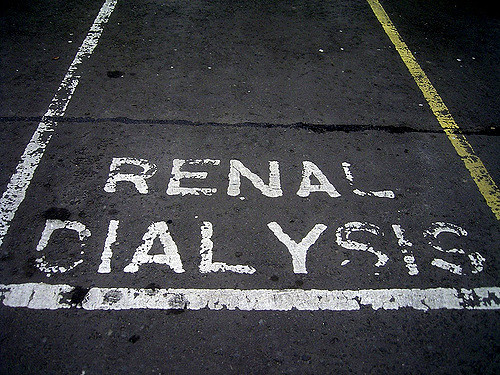
Image courtesy of haileyxb at Flickr.com
Renal Compensation is the mechanism by which plasma, pH, level of acidity are regulated by the kidneys. It could be said that the process is slow but its efficacy allows the kidneys to maintain the desired value of pH. The kidneys are one of the lines of defense used to address acidosis or alkalosis. In order to complete these processes, kidneys requires hormones that contribute to accelerate or bring the required component to the reaction or process. These hormones are the following: Antidiuretic hormone, Aldosterone, Atrial natriuretic peptide, Renin, Erythropoietin, Calcitriol, and Prostaglandin. In the following paragraphs I will explain the function each hormone has on renal compensation process.
Antidiuretic hormone
This hormone, also called Vasopressin, is found most in mammals. The two primary functions of this hormone are to retain water in the body and to constrict blood vessels. In renal compensation, this hormone regulates the body’s retention of water. For doing so, the hormone increases the water reabsorption in the kidney’s collecting ducts. The hormone also increases water permeability of the kidney’s collecting duct. Vasopressin has two main effects by which it contributes to increased urine osmolarity (increased concentration) and decreased water excretion. Its half-life is between 16-24 minutes.
Aldosterone
First isolated in 1953, this hormone is also called “the main mineralocorticoid hormone”. It is produced by the outer section of the adrenal cortex, in the adrenal gland. Its main function is to act on the nuclear mineralocorticoid receptors (MR) within the principal cells of the distal tubule and the collecting duct of the kidney nephron, it upregulates and activates the basolateral Na+/K+ pumps, which pumps three sodium ions out of the cell, into the interstitial fluid and two potassium ions into the cell from the interstitial fluid. This creates a concentration gradient which results in reabsorption of sodium (Na+) ions and water (which follows sodium) into the blood, and secreting potassium (K+) ions into the urine (lumen of collecting duct).
Atrial Natriuretic Peptide
Also called atrial natriuretic factor (ANF),atrial natriuretic hormone (ANH), cardionatrine, cardiodilatin (CDD), or atriopeptin, is a powerful vasodilator, and a protein hormone secreted by heart muscle cells, and it is involved in the homeostatic control of body water, sodium, potassium and fat. The main functions it has on kidney compensation are:
Decreases sodium reabsorption in the distal convoluted tubule and cortical collecting duct of the nephron via guanosine 3′,5′-cyclic monophosphate dependent phosphorylation of ENaC. And the inhibition of renin secretion, thereby inhibiting the renin–angiotensin–aldosterone system.
Renin
Also known as an angiotensinogen, this protein and enzyme is secreted from juxtaglomerular kidney cells, which sense changes in renal perfusion pressure, via stretch receptors in the vascular walls. The juxtaglomerular cells are also stimulated to release renin by signaling from the macula densa. The macula densa sense changes in sodium delivery to the distal tubule, and responds to a drop in tubular sodium load by stimulating renin release in the juxtaglomerular cells. Together, the macula densa and juxtaglomerular cells comprise the juxtaglomerular complex.
Erythropoietin
A protein containing sialic acid that enhances erythropoiesis by stimulating formation of proerythroblasts and release of reticulocytes from bone marrow; it is formed by the kidney and liver, and possibly by other tissues, and can be detected in human plasma and urine. Erythropoietin is produced by interstitial fibroblasts in the kidney in close association with peritubular capillary and proximal convoluted tubule. It is also produced in perisinusoidal cells in the liver. While liver production predominates in the fetal and perinatal period, renal production is predominant during adulthood.

Image courtesy of Reigh LeBlanc at Flickr.com
Calcitriol
Calcitriol is the hormonally active metabolite of vitamin D. It also increases the level of calcium in the blood by increasing the uptake of calcium from the gut into the blood, and possibly increasing the release of calcium into the blood from bone. Synthetic l is prescribed for, among other things, treatment of hypocalcaemia – hypoparathyroidism, osteomalacia (adults), rickets (infants, children), renal osteodystrophy, chronic kidney disease.
Prostaglandins
The Prostaglandins are a group of compounds that have the ability to simulate a reaction in one tissue and inhibit the same reaction in another tissue. The are produced throughout many places of the human body. The diversity of receptors means that prostaglandins act on an array of cells and have a wide variety of effects such as:
- cause constriction or dilation in vascular smooth muscle cells
- cause aggregation or disaggregation of platelets
- sensitize spinal neurons to pain
- induce labor
- decreases intraocular pressure
- regulate inflammation
- regulate calcium movement
- regulate hormones
- control cell growth
- acts on thermoregulatory center of hypothalamus to produce fever
- acts on mesangial cells (specialised smooth muscle cells) in the glomerulus of the kidney to increase glomerular filtration rate
- acts on parietal cells in the stomach wall to inhibit acid secretion
If you are interested on Dialysis, do not miss the previous post “Dialysis common myths and a small approach to their meaning”



